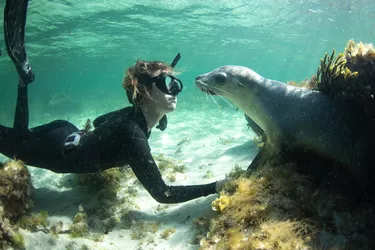
Talk about an interesting occupation: What does an aquatic veterinarian do, and how much can they earn? These professionals care for marine animals and work at zoos, aquariums, charitable organizations and research facilities. Their patients include marine mammals, reptiles, invertebrates and, of course, fish. While the job description is similar to that of a regular veterinarian, only aquatic ones have to get their feet wet.
Aquatic Veterinarian Salary
Video of the Day
Although the experts at the U.S. Bureau of Labor Statistics don't provide a specific category for aquatic veterinarians, they have similar ones that can provide insight as to how much these professionals earn. One is zoologists and wildlife biologists; they study animals and other forms of wildlife and how they relate to their different ecosystems. The median pay for this kind of work is $64,650 a year, and a bachelor's or master's degree is required.
Video of the Day
How much does a vet make, though? They earn significantly more, with an average pay of $100,370 a year. They must earn a Doctor of Veterinary Medicine degree from a veterinary college and be state-licensed to work. There were 86,800 employed veterinarians in this country in 2020, and this field is projected to grow by 17 percent by 2030. Since these marine veterinarians are more specialized, it's possible that an aquatic veterinarian salary would be considerably higher.
Average Salary for a Vet by State
According to the BLS, certain states provide higher average salaries for veterinarians, and the highest-paying ones are on the east and west coasts. For example, a vet salary in California ranges from $114,460 to $137,730, according to May 2021 data. Other states showing higher salaries include New York, Pennsylvania, New Jersey, Maryland, Connecticut and Massachusetts. A veterinarian salary in Florida was lower on average, ranging from $105,660 to $113,910; other states in this pay range included Texas, Virginia, Oregon and Washington State.
Some of the lowest-paying states for veterinary salaries were Illinois, North Dakota, Idaho, Colorado and Utah. At the bottom were New Mexico, Montana, South Dakota, Iowa, Wisconsin and Arkansas, among others. These lowest salaries ranged from $68,340 to $96,240. Keep in mind that the highest-paying ones could also have higher living costs. The states that had the largest numbers of working veterinarians were California (7,620), Texas (5,400), Florida (4,790), New York (3,640) and Ohio (3,330).
Aquatic Veterinarian Job Description
The educators at St. George's University explain that aquatic veterinarians spend their days dealing with their marine patients and handle everything from comprehensive medical exams to performing surgeries. They administer tests, vaccinations and anesthesia, treat wounds and respond to more serious emergency situations. Marine vets also participate in scientific research, observe and analyze animal behaviors, run laboratory diagnostics and implement nutrition plans; the sad part of the job is needing to administer end-of-life care and euthanasia.
Aquatic veterinarians work in different settings, and it's not always next to bodies of water. Some spend time outdoors by oceans, while others work in laboratories most of the time, doing research. Other places of employment include zoos, aquariums, harbors, sanctuaries and universities.
If you're considering becoming a veterinarian, but you don't think you can afford veterinary school, consider applying for scholarships. The Association of Women Veterinarians Foundation offers aid to second- and third-year female veterinary students, and to qualify, applicants must be attending a U.S. or Canadian veterinary school. The National Institute of Food and Agriculture also offers its Veterinary Services Grant Program (VSGP), the Rural Practice Enhancement Grant (RPE) and the Veterinary Medicine Loan Repayment Program. These were created to address veterinarian shortages and were authorized by the 2014 Farm Bill; prospective veterinarians are encouraged to look into these programs to see if they are eligible.
- U.S. Bureau of Labor Statistics: Zoologists and Wildlife Biologists
- U.S. Bureau of Labor Statistics: Geographic Profile for Veterinarians
- St. George's University: What Does an Aquatic Veterinarian Do? Understanding the Role of These Underwater Animal Doctors
- U.S. National Institute of Food and Agriculture: Veterinary Services Grant Program